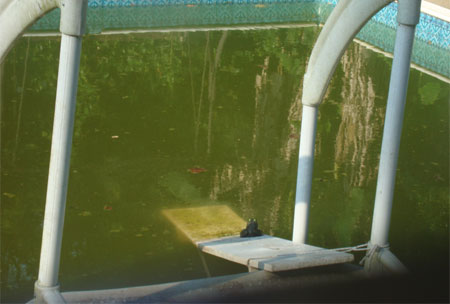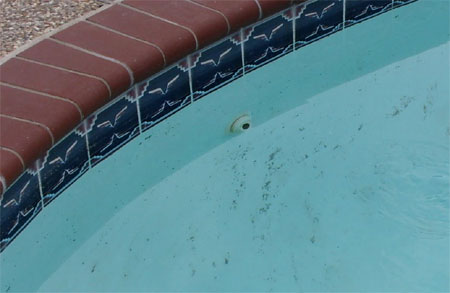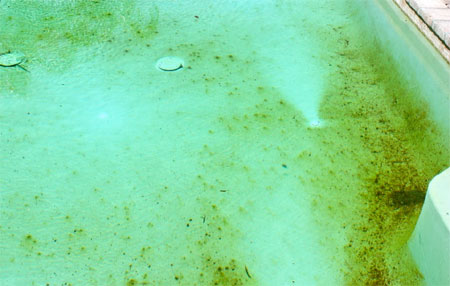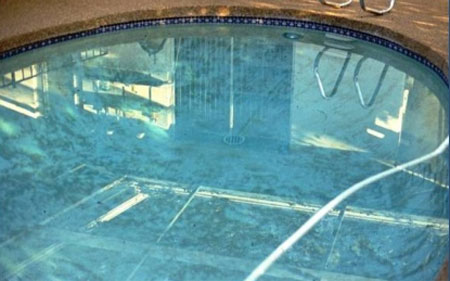Summer is just around the corner, and that means hot days and cold dips in the pool. Before it's too late to tackle any problems or repairs yourself, inspect your pool now and take action to remedy any repairs.

If your swimming pool is starting to look like a crocodile infested swamp - it's time to get take remedial action. The first step is to identify the problem: Stains in a swimming pool can be caused by metals in the pool water, or by algae and the best clue to the source of the problem is the colour of the stain.
How to get rid of Algae
Almost every swimming pool owner has, at one time or another, done battle with the occasional green spots and murky pool water. During the windy seasons and summer storms, algae spores contaminate a pool, driven by wind and rain. When pool water is unbalanced, algae spots can occur seemingly overnight. Warm temperatures, sunlight and the presence of nitrates and/or carbon dioxide - all can easily create the perfect situation. Of course, a lack of proper circulation, filtration and sanitation may be the primary cause of the algae.
Like the weeds in your garden eventually overtake when left unattended, algae builds up to such a level that is clogs up the filter - minimising filter effectiveness and requiring more backwashing. Algae also consumes chlorine that should be working on other contaminants.
Black Algae

If you wake up one morning and find black algae spots on the sides of yourmarbelite pool, it's time to take immediate action. Black algae spots occur in swimming pool water that has a low free chlorine level and/or the pool chemicals are unbalanced. Good circulation is a must!
Because black algae is resistant to chlorine, throwing in a couple of cups of chlorine - or even a shock pack - won't have any effect. The only way to get rid of black algae is to use the correct chemicals, a stiff pool brush and algaecide.
It's not an easy process to remove black algae spots, so be prepared to roll up your sleeves, slap on some suntan lotion and be ready to start brushing loose the algae. Because black algae forms a protective barrier around itself, you need to brush the affected areas really hard with a stiff brush, so that an algaecide can do the job.
Once all the black algae has been brushed off, pour algaecide into the pool; leaving the pump off overnight, or as specified by the manufacturer.
Brush again in the morning, adjust the pH and correct the chlorine level. Keep your pool chlorine level adjusted to 7.2 - 7.6) to prevent reoccurrence and the chlorine residual at 1.0-3.0ppm.
Common treatment:
- Test the pH of your water and adjust to between 7.2 and 7.6
- Use a stiff pool brush to vigorously scrub the algae infested area. Black algae builds up a protective slimy coating, so you may need to be quite a bit of brushing.
- Set the pump on backwash to clean out the filter
- In the early evening, shock treat with 1 pack of HTH Shock It
- The following morning, place the pump on circulate/re-circulate/bypass position and add 1 bottle of Black Algaecide around the sides of the pool
- In the early evening, brush down the walls of the pool and place the pump back to the filter position
Green Algae

The most common algae found in swimming pools is green algae, and this type of algae is very quick to make itself known in unbalanced water. It clings to walls, builds up on pool cleaning equipment and reduces water clarity.
While correct chemical balance and sanitizer residuals will prevent many opportunities for algae to bloom, a pool with high pH and low chlorine can give algae a growth boost. It is essential that regular, preferably daily, emptying of filter baskets be done, as organic material and bacteria can contribute to algae growth and regular brushing of the sides of a marbellite pool prevents algae growth.
Common treatment
- Test the pH of your water and adjust to between 7.2 and 7.6
- Set the pump on backwash to clean out the filter
- Re-set back to filter position and pour 1 bottle of Green Algaecide around the inside of the pool. Leave this to circulate overnight.
- In the morning, brush down the sides of the pool with a stiff pool brush to loosen any stubborn algae.
- For any algae that remains in the pool, apply 1 pack of HTH Shock It.
Dark Brown or Yellow Stains

Stains that appear light tan (mustard), reddish brown or bluish-black are typically related to metals in your pool water. You can confirm this by brushing the stain with a stiff brush. If the stain is hard to remove, chances are it is metal stains. The metals that commonly cause pool stains are iron, manganese and copper. Copper will result in blue, almost black stains, while iron results in rusty, brown or green/brownish stains. If manganese is present it will result in dark brownish/black or purple stains.
Where a pool is filled from a borehole it's a good idea to take a sample of your pool water to have it tested for metals and it is essential to use Metal Remover regularly when topping up a pool, because metal stains can be almost impossible to remove.
If you believe your stain is related to metals, or if the suggestions above for organic pool stains do not lighten or improve the stain, you should purchase a natural ascorbic acid (Vitamin C) based pool product. When applied directly to the stain, these powerful pool chemicals will almost instantly remove the stain from the pool surface.






0 comments:
Post a Comment